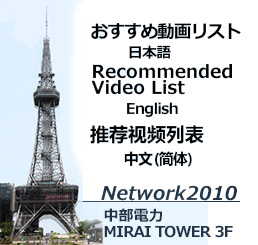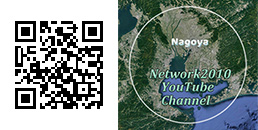- Nagoya in the Edo period(1603-1868)
- ①The Okehazama ancient battlefield
- ②Arimatsu to Miya post‐town
- ③Miya post-town
- ④Atuta Shrine
- ⑤Atsuta~Furuwatari
- ⑥Tachibana-cho
- ⑦Osu Kannon Temple
- ⑧Osu Monzencho
- ⑨Shirakawa Park
- ⑩Nagoya Castle Town 01
- ⑪Nagoya Castle Town 02
- ⑫Toshogu Shrine Festival
- ⑬Horikawa River1
- ⑭Horikawa River2
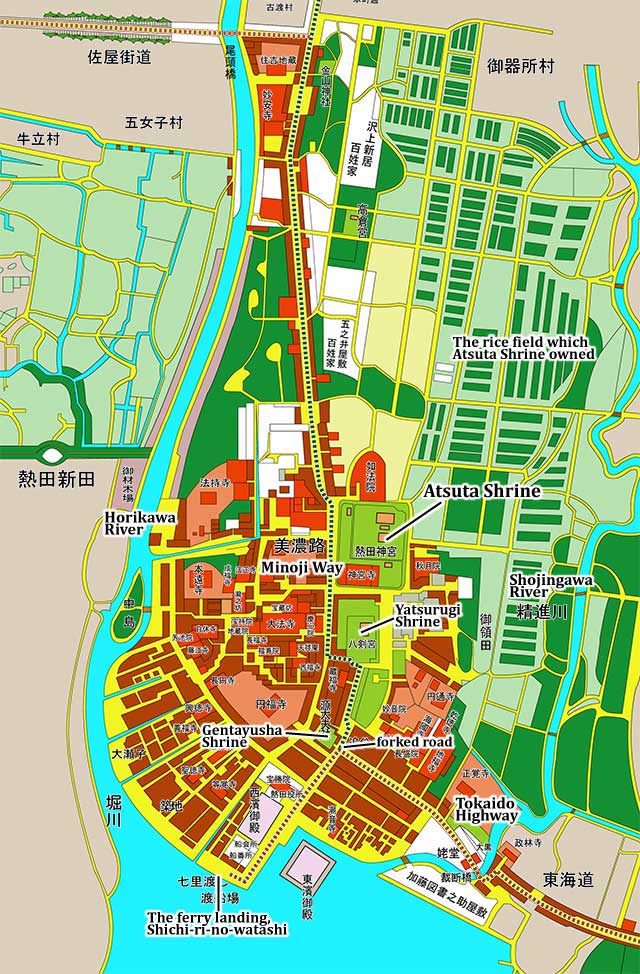
Atsuta Shrine territorial area figure
Atusta Shrine is home to "Kusanagi-no-Tsurugi(a sword)", which is one of the Three Sacred Imperial Treasures. This is the 2nd largest shrine after Ise Shrine in Mie Prefecture, and about 6.5 million people visit there annually.
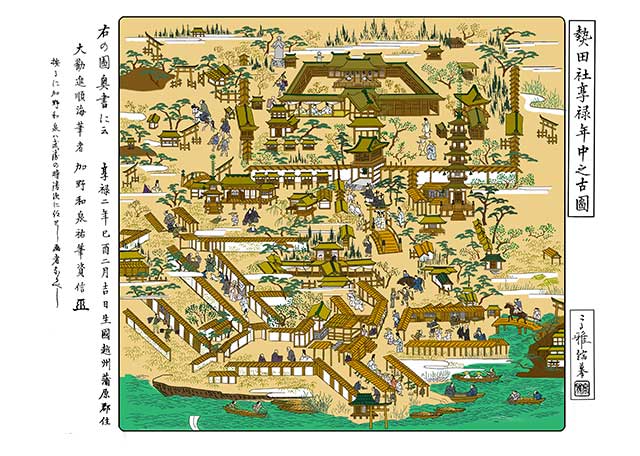
Atsuta Shrine old figure(1528~31)
The outskirts of Atsuta Shrine in the age of Warring States Period (1528-31) was drawn.Digital coloring was performed although the original picture was a monochrome painting.
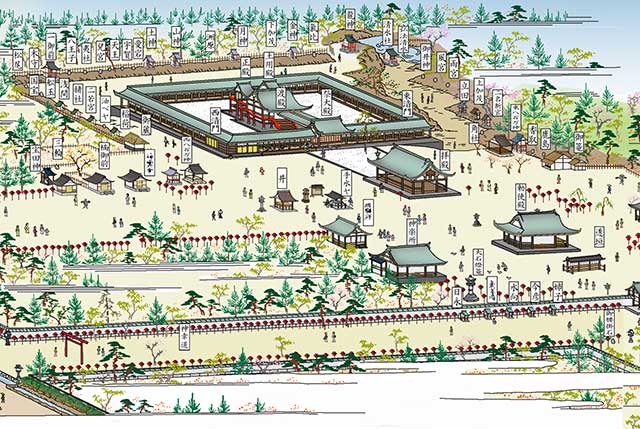
Atsuta Shrine
Atuta Shrine is home to the "Kusanagi-no-Tsurugi(sword )",which is one of the Three Sacred Imperial Treasures. This is the 2nd largest shrine after Ise Shrine in Mie Prefecture,and about 6.5 million people visit there annually.
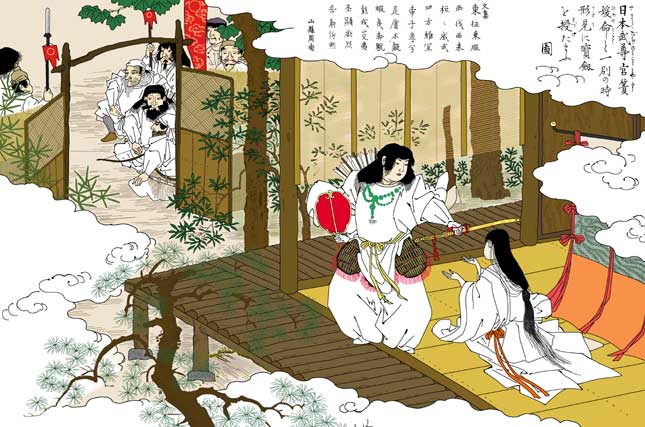
Yamato Takeru no Mikoto and Kusanagi-no-Tsurugi sword
Yamato Takeru no Mikoto was born as a child of the 12th generation Emperor Keiko. He suppressed Japanese every place in response to Emperor's command. He met with Miyazuhime on the way to suppression of eastern provinces, and he promised marriage and it was left. Miyazuhime is a daughter of the powerful clan of Owari and the elder brother was serving in a war for suppression of eastern provinces as a vice-general of Yamato Takeru no Mikoto. The command which conquers the mountain god of Mt.Ibuki went down after suppression of eastern provinces. He left Kusanagi-no-Tsurugi sword to Miyazuhime, seeing an enemy's power lightly, and went to suppression. Yamato Takeru no Mikoto encountered unexpected strong resistance, and had become sick. He lost his life on Nobono in the middle of returning to the Yamato Imperial Court. It is told that he became a swan and returned to the hometown.
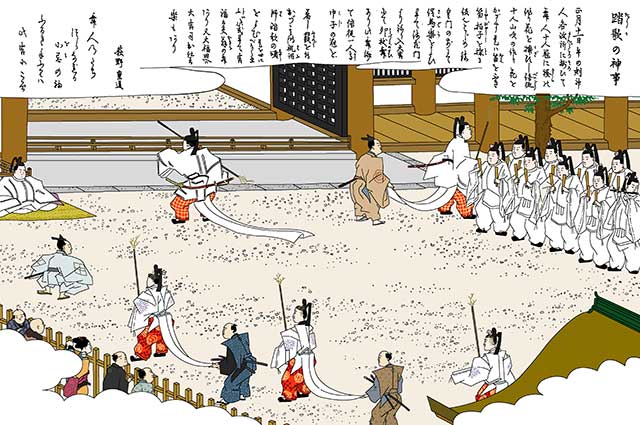
Toka-Shinji(the Shinto ritual)
Toka Shinji Shinto rites is performed on January 11 every year. The purpose is Shinto rites which prays for warding off calamities and good luck charm by calming the spirit of a departed person which dwells in the ground. From the Nara period (710-794) , it is carried out by the Imperial Court, and continued till the present. Beiju(the Emperor's attendant) sings a song and bugaku dancers perform dancings which are called Uzue-no-mai,Ogino-mai. After dancing finishes, in accordance with Shomon(imperial decree), a Shinto priest who played the role of Kokojyaku sounds Furi-tsuzumi(the handles of den-den drums) . Each visitor hears the sound and divines destiny of the year. This Shinto rites is also called "Ararebashiri" and "Oberobero Matsuri Festival.
Video
【Video】Toka-Shinji(the Shinto ritual)
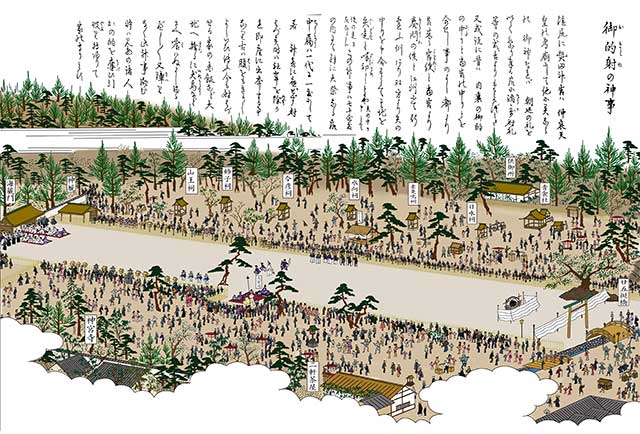
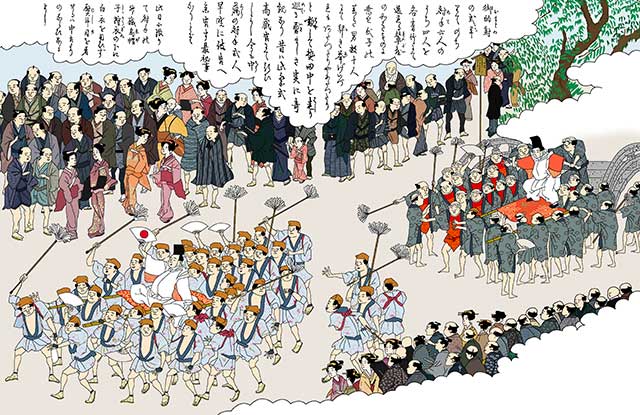
Hosha-Shinji(the Shinto ritual)
KO-negi(primary priest) distributes Kuitsumi(The dish of New Year's greetings) to Shinto priests in front of the big target, and offers Miki(sacred sake). An arrow is shot towards the sky, the ground and the big target after exorcism rite. Among the people, Hosha Shinji Shinto rites is called "Omato." This divine work is religious services which prays for a good harvest and warding off calamities.A character called 鬼 (Oni) is written to the reverse side of the big target, and the diameter is 1.8m.3 sets of Shinto priests who construct two persons shoot an arrow in order. The last two arrows are shot simultaneously. It is believed that Chigi wood attached in the center of the big target is effective in charm against misfortunes. If the last arrow is shot, visitors to the shrine will run with might and main, in order to take Chigi wood.
Video
【Video】Hosha-Shinji(the Shinto ritual)
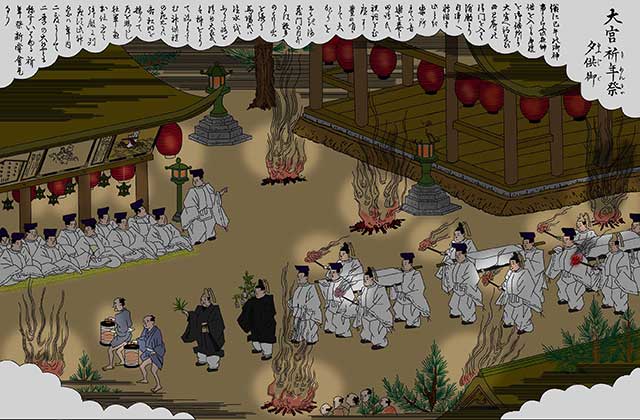
Kinensai-Yu-Kugyo(The Shinto ritual which offers supper on God)
This religious services is a regularly held festival which prays for the good harvest of forest and fishery products in advance of spring. This is the festival which carries the chest containing an offering to the spirits of one's ancestors to Naijin(the place with the object of worship in a Shinto shrine). Countless lights are burned with big bonfires. In Japan, people have believed that God gets down to a village in the beginning of spring in order to watch a life of people, and returns to a mountain after the harvest of autumn from of old.
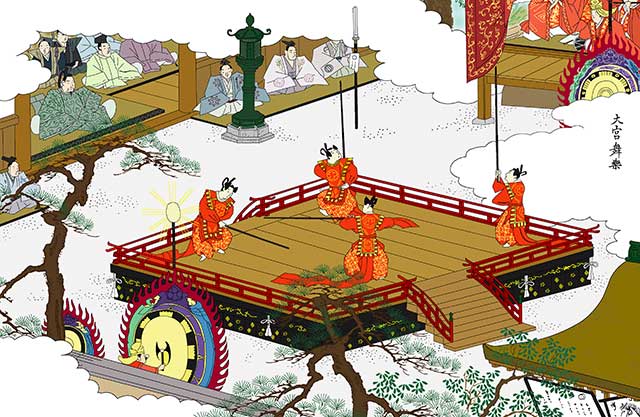
Bugaku-Shinji(bugakucourt dances and music)
Bugaku is ancient court music accompanied by dancing. There are two kinds of Bugaku, Togaku which descended from China in T'ang era and Komagaku transmitted from Korea to Japan. In Atsuta Shrine Bugaku, Enbu for purification , Chogeishi performed by conclusion of a public performance, etc.are performed.
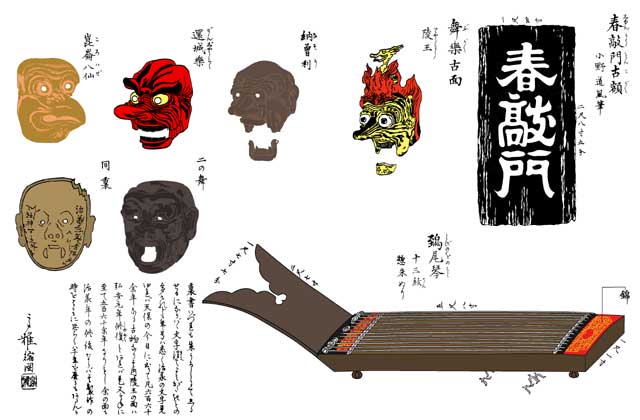
Framed picture decorated at Shunko-mon gate and mask worn by a bugaku dancer
Shunko-mon was the east gate in Atsuta Shrine burned down by war devastation. This framed picture was applied with a lacquer,and was gilt in the bottom. However, gold only remains slightly now.
The original of Owari-meisho-zue
-

The original of Owari-meisho-zue
-
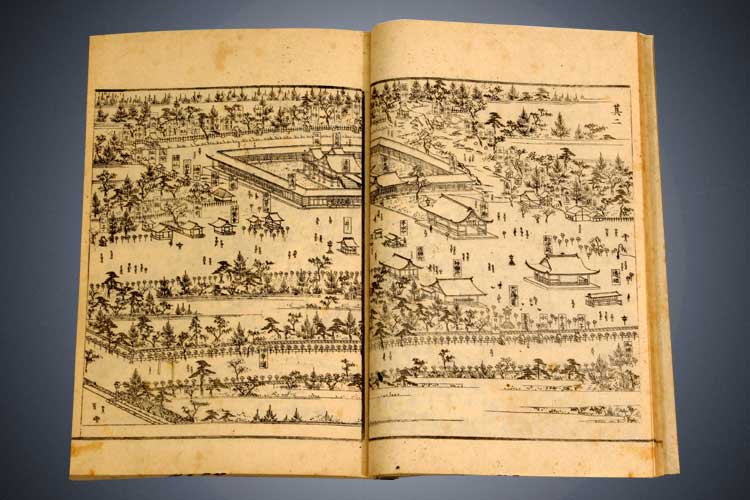
The original of Owari-meisho-zue
-
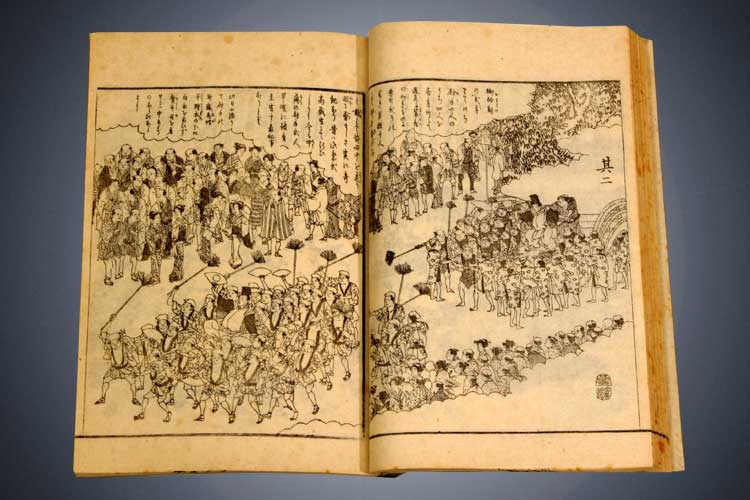
The original of Owari-meisho-zue
-
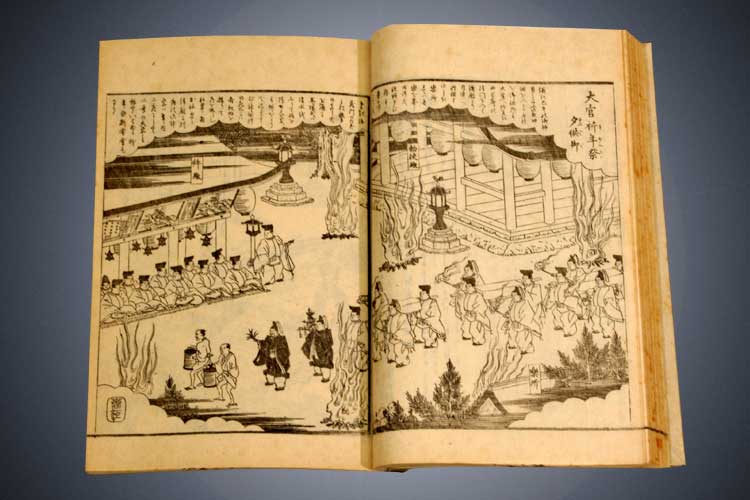
The original of Owari-meisho-zue
-
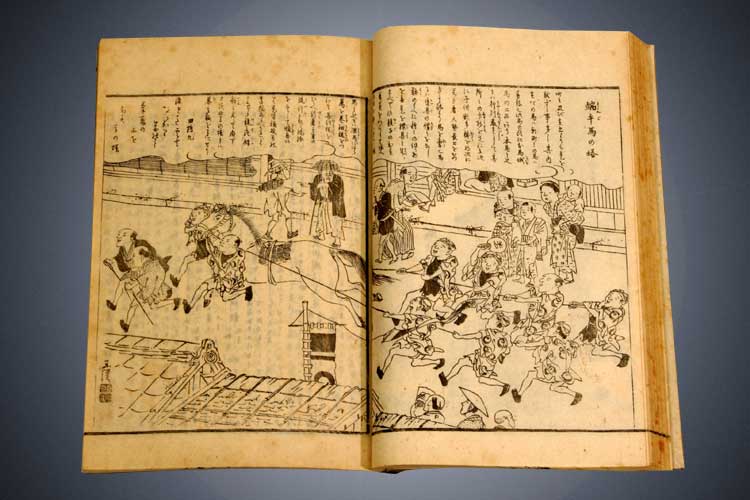
The original of Owari-meisho-zue
-
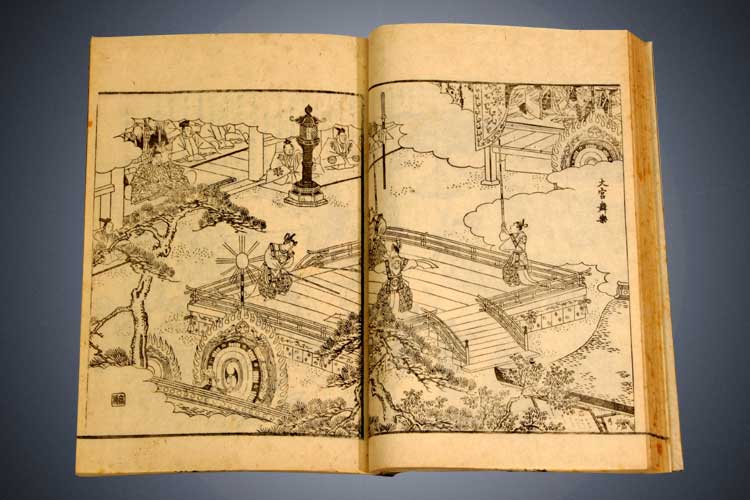
The original of Owari-meisho-zue

